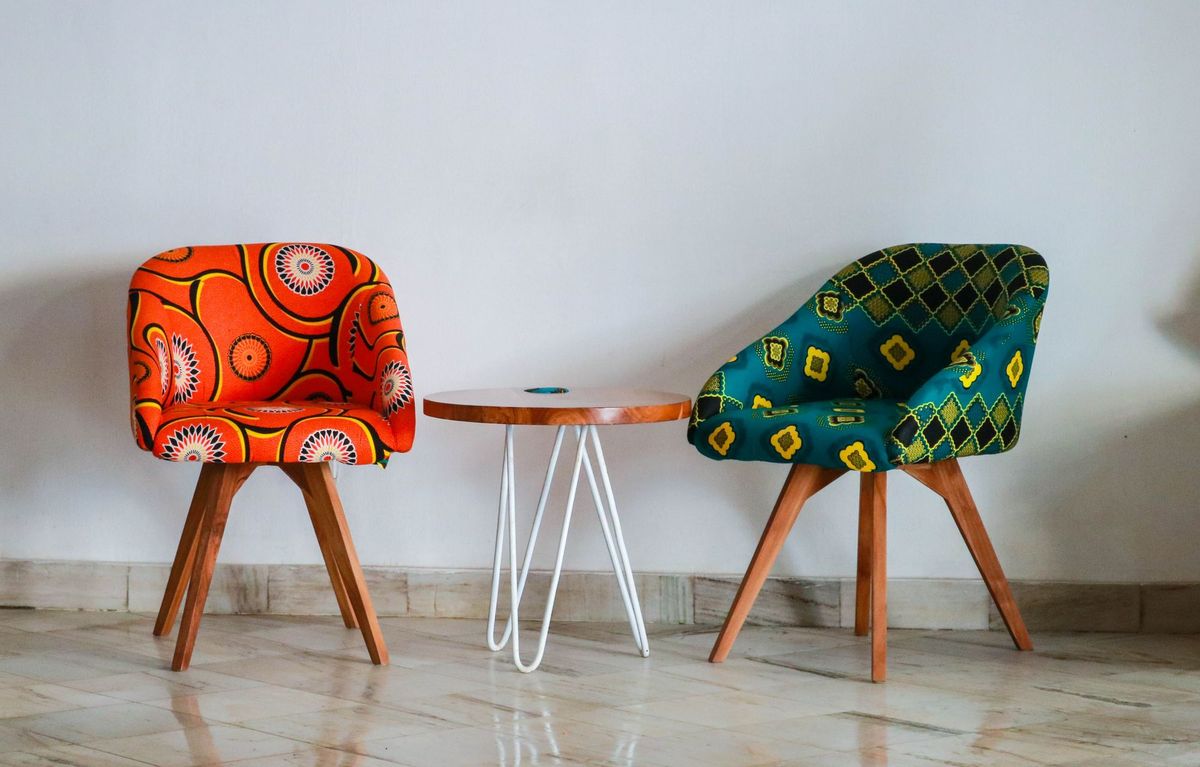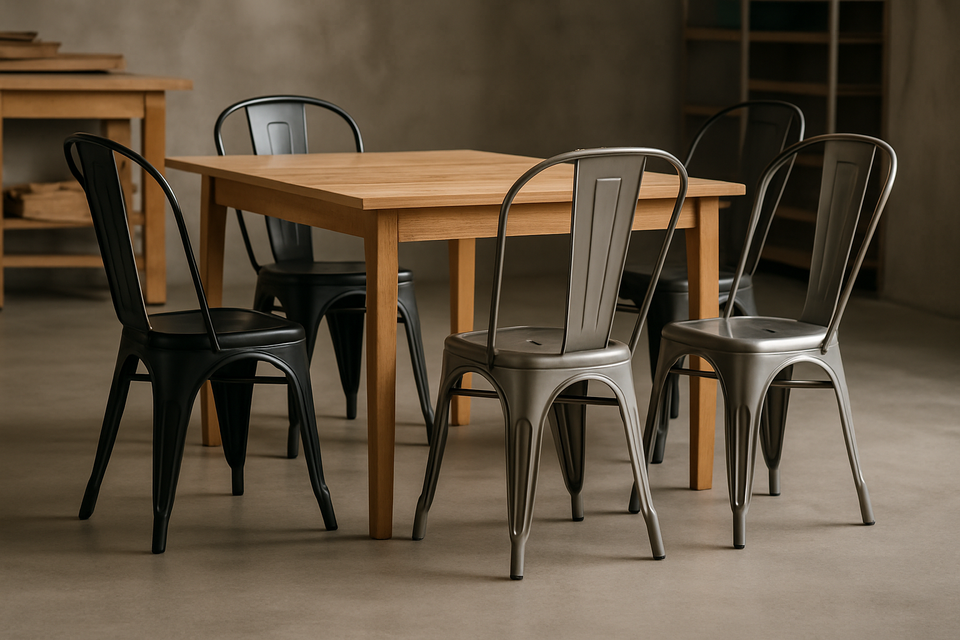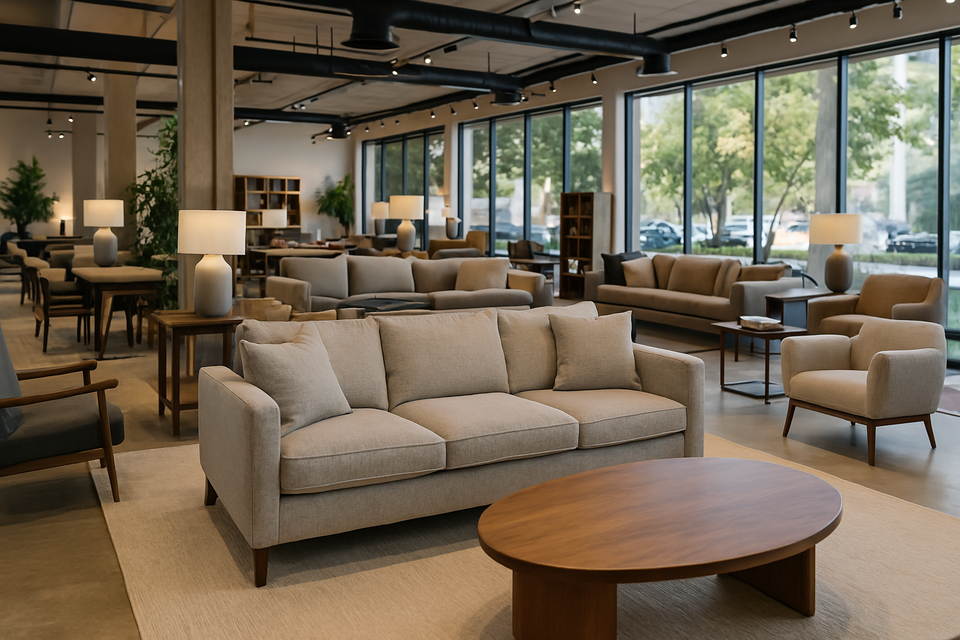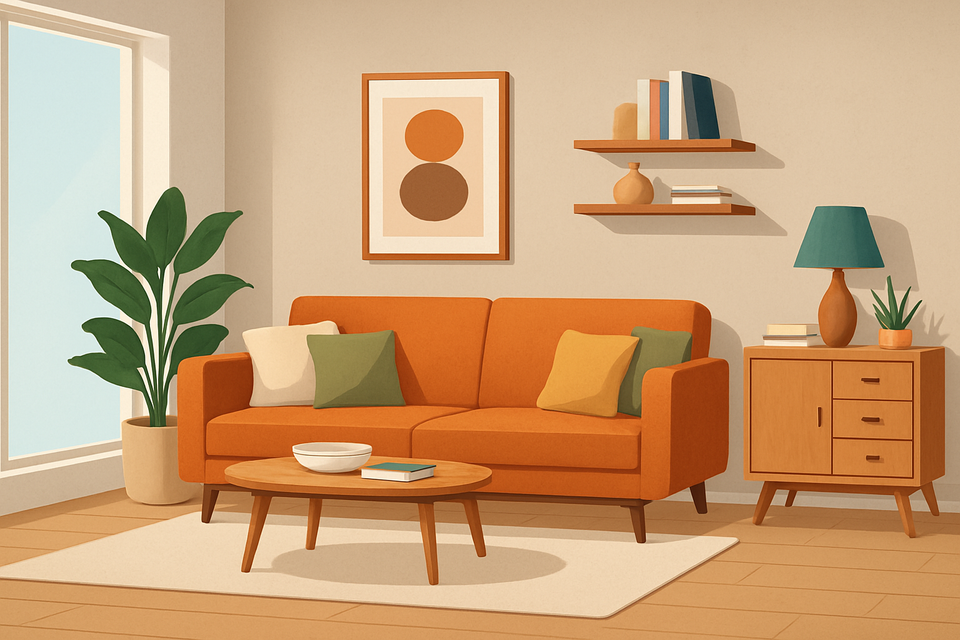10 Tips While Selecting Chair for Your Home

While moving, redecorating, or purchasing a new home, the most challenging aspect of designing contemporary homes is selecting the proper type of furniture shops in Delhi. Chairs have remained consistent among the new personalized furniture constantly being introduced to the market.
No furniture could ever substitute chairs, and in this day and time, when everyone is occupied with their life, it might be challenging to pick the correct type of chair that will provide people with comfort and relaxation for their time while also giving their modern homes an aesthetically pleasing appeal to Luxury furniture stores in Delhi.
To assist you in resolving this difficulty, we have compiled a list of tried and true guidelines for selecting the ideal chair for your home.
Tips For Choosing The Perfect Chair
- Height of the chair- The seat height of an office chair should be freely adjustable. The most convenient method is to use a pneumatic adjustment lever. The chair's height should assist you in sitting with your feet firm on the floor, your thighs horizontal, and your arms parallel with the level of the buy coffee table.
- Back support- According to studies, seats without dedicated spinal support force the back to bend forward in an uneven curve. This causes the lumbar muscles to strain and be dragged out of their proper position, causing the muscle groups to tire.
- Armrest- Purchase a home chair with armrests to relieve pressure on your shoulders and neck. The armrests should also be movable so that you can place them so that your arms can lie comfortably while reducing your tendency to slump.
- Durability- Your chair can decay over time, and its effectiveness will suffer; material stiffness can be lost, numerous systems will deteriorate, and comfort can just wain over time.
- Design of the chair- When selecting the perfect chair, consider the edges of the chair, the form, the level of the chair, and the overall aesthetic. Different bads' latest furniture designs for bedroom might reflect various functions that are appropriate for multiple times.
- Comfort- A chair should have adjustable elements such as seat height and depth, front inclination, armrests and headrests, and back support. Seat materials should give enough lower back support and promote good posture.
Best Chair Types For Your Home
Lounge Chair

A lounge chair is designed with comfort in mind and is meant for relaxation. Here are more details about lounge chairs:
Upholstery:
- Lounge chairs are typically upholstered with soft materials like fabric, leather, or suede for maximum comfort.
- The upholstery can come in various colors and patterns to match the overall aesthetics of your home.
Frame:
- The frame of a lounge chair can be made from different materials, including wood, metal, or a combination of both.
- Wooden frames often give a classic and timeless look, while metal frames can offer a more modern and sleek appearance.
Reclining Features:
- Many lounge chairs have a reclining feature, allowing you to adjust the backrest to your preferred angle for optimal comfort.
- Some designs may also include a built-in footrest or an ottoman for complete relaxation.
Style:
- Lounge chairs come in various styles, ranging from contemporary and modern designs to classic and vintage-inspired looks.
- Popular styles include the mid-century modern lounge chair, the classic leather club chair, and the sleek contemporary recliner.
Size and Dimensions:
- Lounge chairs come in different sizes to accommodate various spaces. Some are designed to be more compact for smaller rooms, while others are more substantial and can serve as a statement piece.
- Consider the dimensions of the chair in relation to the available space and how it complements other furniture in the room.
Additional Features: Some lounge chairs may have additional features like built-in cup holders, USB ports for charging devices, or even massage and heating functions for added luxury.
Placement:
- Lounge chairs are versatile and can be placed in various areas of the home, including the living room, bedroom, or a dedicated reading nook.
- Consider the overall layout of your space and the purpose of the chair when deciding where to place it.
Brands and Designers: There are well-known designers and brands that specialize in lounge chairs, offering high-quality craftsmanship and unique designs. Examples include the Eames Lounge Chair by Charles and Ray Eames or the Barcelona Chair by Ludwig Mies van der Rohe.
Choosing a lounge chair involves considering your personal style, the existing decor of your home, and, most importantly, your comfort preferences. Whether you prefer a classic leather recliner or a modern, fabric-covered lounger, the right lounge chair can enhance the overall comfort and aesthetic appeal of your living space.
Accent Chair

An accent chair is a versatile and stylish piece of furniture that is designed to complement the overall decor of a room. Here are more details about accent chairs:
Purpose: An accent chair is primarily used to enhance the visual appeal of a space. It serves as a decorative element that stands out from the rest of the furniture in a room.
Style:
- Accent chairs come in a wide variety of styles, from traditional to modern, and can feature unique designs, patterns, and materials.
- They are an excellent way to add a pop of color, texture, or pattern to a room, creating visual interest.
Size and Shape:
- Accent chairs are generally smaller in size compared to other seating options like sofas or recliners. Their compact size allows for placement in various areas of a room.
- The shape of accent chairs can vary, including classic armchairs, slipper chairs, and more contemporary designs.
Upholstery:
- Upholstery options for accent chairs are diverse, ranging from fabrics like linen, velvet, and leather to patterns such as floral, geometric, or solid colors.
- The choice of upholstery can significantly impact the overall aesthetic and feel of the room.
Placement:
- Accent chairs can be strategically placed in different areas of a room to create a focal point or balance the overall design.
- Common placements include next to a fireplace, in a corner, or as part of a seating arrangement in a living room.
Functionality:
- While the primary purpose of an accent chair is decorative, it can also serve functional roles such as providing additional seating when needed.
- Some accent chairs may have features like swivel bases, reclining mechanisms, or rocking capabilities for added versatility.
Coordination: Accent chairs are often chosen to coordinate with the existing furniture and color scheme in a room. They can either complement or contrast with the surrounding decor to achieve a balanced look.
Mix and Match: Mixing and matching different styles and patterns is a popular trend when it comes to accent chairs. This allows for a more eclectic and personalized look in the room.
Materials and Finishes: Accent chairs can be made from various materials, including wood, metal, or a combination of both. The choice of materials and finishes contributes to the overall style of the chair.
Price Range: Accent chairs are available in a wide price range, making them accessible for various budgets. Higher-end options may feature premium materials and designer craftsmanship.
Whether you choose a bold, statement-making accent chair or a more subtle and complementary piece, it's essential to consider how it fits into the overall design scheme of your home. Accent chairs are a great way to express your personal style and add character to your living spaces.
Armchair

An armchair, also known as an armchair or lounge chair, is a comfortable and often upholstered chair with armrests. Here are more details about armchairs:
Design and Structure:
- Armchairs are characterized by the presence of armrests on either side of the seat. The armrests can be an integral part of the frame or attached as separate components.
- They typically have a supportive backrest and a comfortable seat cushion.
Comfort: Armchairs are designed for comfort, providing a cozy and inviting seating option. The addition of armrests contributes to a relaxed and supportive sitting experience.
Upholstery: Armchairs come in a variety of upholstery materials, including fabric, leather, velvet, and microfiber. The choice of upholstery can impact both the comfort and aesthetics of the chair.
Styles: Armchairs are available in a wide range of styles to suit different preferences and interior design themes. Common styles include traditional, modern, mid-century modern, and contemporary designs.
Size and Dimensions:
- The size of armchairs can vary, with some being more compact for smaller spaces and others offering a more substantial and statement-making presence.
- It's important to consider the dimensions of the armchair in relation to the available space in the room.
Versatility: Armchairs are versatile and can be used in various rooms within the home, including the living room, bedroom, home office, or even as accent pieces in hallways or entryways.
Coordination with Decor: Armchairs are often chosen to complement the overall decor of a room. They can match existing furniture or stand out as accent pieces, depending on the design goals.
Accent Features: Some armchairs come with additional features such as tufted upholstery, nailhead trim, or decorative patterns, adding visual interest to the chair.
Placement:
- Armchairs are commonly placed in living rooms as part of seating arrangements, either as standalone pieces or alongside sofas and coffee tables.
- They can also be used in bedrooms as cozy reading chairs or in home offices for a comfortable and supportive work seat.
Reclining Options: While not all armchairs recline, some models come with reclining features, allowing users to adjust the backrest for a more relaxed and laid-back position.
Price Range: Armchairs are available at various price points, making them accessible for different budgets. Higher-end armchairs may feature premium materials and craftsmanship.
Whether you're looking for a classic leather armchair, a sleek modern design, or a cozy oversized option, armchairs offer a comfortable and stylish seating solution for different areas of your home.
Rocking Chair

Rocking chairs have a timeless appeal, providing not only a comfortable seating option but also a sense of nostalgia and relaxation. Whether indoors or outdoors, modern or traditional, a rocking chair can be a wonderful addition to your home, offering both aesthetic value and functional benefits
Design Features:
- Rocking chairs can have various design features, including different backrest shapes (spindle, slat, ladder-back), curved or straight armrests, and intricate detailing.
- Some rocking chairs have a wide seat with ample space, while others may be more compact and streamlined.
Upholstery and Cushions:
- Rocking chairs can be upholstered with different materials, including fabric, leather, or vinyl. The addition of cushions or padding enhances comfort, especially for extended use.
- Upholstered rocking chairs are common in nursery furniture for added comfort during late-night feedings.
Swivel and Glider Rockers:
- Some modern rocking chairs come with additional features like swivel or glider mechanisms. Swivel rockers can rotate 360 degrees, providing a broader range of movement.
- Glider rockers move in a smooth, gliding motion back and forth, providing a more linear movement compared to the traditional arc of a rocking chair.
Folding Rocking Chairs: For those with limited space, folding rocking chairs are available. These chairs can be easily folded and stored when not in use, making them convenient for small apartments or outdoor activities.
Vintage and Antique Rocking Chairs: Antique rocking chairs often feature handcrafted details, intricate carvings, and unique designs. Vintage or antique rocking chairs can add a touch of history and character to a space.
Materials and Finishes: Rocking chairs can be made from a variety of materials, including wood, metal, plastic, or a combination of materials. Wooden rocking chairs are classic and come in various finishes, while metal and plastic options offer a more modern aesthetic.
Outdoor Rocking Chairs: Outdoor rocking chairs are specifically designed to withstand the elements. They are often made from materials like teak, cedar, or weather-resistant metal and may include UV-resistant cushions.
DIY Rocking Chair Kits: Some enthusiasts enjoy building their own rocking chairs from DIY kits. These kits provide all the necessary materials and instructions for assembling a rocking chair from scratch.
Rocking Chair for Health Benefits: The rocking motion of a rocking chair has been associated with health benefits such as improved circulation, reduced stress, and enhanced relaxation. It can also be beneficial for individuals with conditions like insomnia.
Cultural Significance: Rocking chairs hold cultural significance in various regions. In some cultures, they are associated with stories told on porches, while in others, they symbolize comfort and hospitality.
Maintenance: Depending on the material, rocking chairs may require different levels of maintenance. Wooden rocking chairs may need periodic polishing or sealing, while outdoor rocking chairs may require protective coatings.
Dining Chair

A dining chair is a piece of furniture specifically designed for seating at a dining table. Its primary function is to provide a comfortable and supportive seat for individuals during meals. Dining chairs come in various styles, materials, and designs to complement different dining room aesthetics and personal preferences. Here are some key details about dining chairs:
Materials:
- Wood: Many dining chairs are made from wood, offering durability and a classic look. Common types of wood include oak, mahogany, maple, and pine.
- Metal: Some dining chairs feature metal frames, often combined with other materials like upholstered seats or wooden accents.
- Upholstery: Chairs may have padded seats and backs with upholstery materials such as fabric, leather, or vinyl for added comfort.
Styles:
- Traditional: Classic designs with details like turned legs, carved elements, and rich finishes.
- Modern/Contemporary: Clean lines, minimalistic designs, and often made with materials like metal and plastic.
- Transitional: A blend of traditional and modern elements, offering a versatile and timeless look.
Types:
- Armchairs: Chairs with arms on either side, providing additional support and comfort.
- Side Chairs: Armless chairs typically placed along the sides of the dining table.
- Parsons Chairs: Simple, upholstered chairs with a straight back and no arms, known for their versatility.
Design Features:
- Backrest: The backrest can be straight, curved, or contoured for ergonomic support.
- Legs: Dining chair legs can vary in design, including straight, tapered, or turned legs.
- Seat Shape: Seats can be square, round, or have a custom shape based on the chair's design.
Dimensions: Dining chairs are typically designed to be a comfortable height for sitting at a standard dining table, allowing enough space for a person to sit comfortably and access the table.
Functionality: Some dining chairs are stackable or foldable, making them convenient for storage when not in use.
Customization: Many manufacturers offer customization options, allowing customers to choose the type of wood, upholstery fabric, and other details to match their preferences.
When selecting dining chairs, it's essential to consider the overall design of your dining room, the comfort level, and how well they complement your dining table. Additionally, factors like maintenance, durability, and ease of cleaning should also be taken into account.
Office Chair

Office chairs are a type of chair designed specifically for use in an office setting, providing comfortable seating for individuals who spend extended periods working at a desk or computer. Here are more details about office chairs:
Ergonomics:
- Adjustability: Office chairs are often designed with multiple adjustable features to accommodate different body types and preferences. Common adjustments include seat height, armrest height, backrest angle, and lumbar support.
- Lumbar Support: Many office chairs feature built-in lumbar support to maintain the natural curve of the spine and reduce lower back strain.
Materials:
- Mesh: Mesh-backed chairs provide breathability, promoting air circulation to keep the user cool during long periods of sitting.
- Leather: Executive office chairs often feature leather upholstery, providing a luxurious and professional appearance.
- Fabric: Chairs with fabric upholstery are comfortable and come in a variety of colors and patterns.
Types:
- Task Chairs: Basic office chairs suitable for general use and shorter periods of sitting.
- Executive Chairs: Larger, more luxurious chairs often associated with high-ranking executives, featuring high backs, leather upholstery, and additional padding.
- Conference Chairs: Designed for use in meeting rooms or conference areas, these chairs may have a simpler design but still offer comfort for shorter durations.
Wheels and Swivel Base:
- Most office chairs come with wheels (casters) to facilitate easy movement around the workspace.
- The swivel base allows users to turn and reach different areas of their desk without straining.
Armrests: Armrests provide additional support for the arms and shoulders. They are often adjustable in height and can be either fixed or removable, depending on the chair design.
Tilt Mechanism: Many office chairs have a tilt mechanism that allows the seat and backrest to tilt together or independently. This feature helps users find a comfortable reclined position.
Headrest: Some office chairs come with a built-in headrest or a separate adjustable headrest to support the neck and head, promoting better posture.
Weight Capacity: Office chairs are designed to support a specific weight capacity. It's important to choose a chair that can comfortably accommodate the user's weight.
Aesthetics: Office chairs come in a range of designs, from modern and sleek to more traditional styles, allowing users to choose one that complements the overall office decor.
Durability: Consider the durability of materials and construction to ensure the chair can withstand regular use over an extended period.
Choosing the right office chair is crucial for maintaining comfort and promoting good posture during long working hours. Ergonomic features and personal preferences play a significant role in selecting an office chair that best suits individual needs.
Bar Stool

Bar stools are tall stools designed for seating at a bar or a high counter, such as those found in kitchens, home bars, or commercial establishments like restaurants and pubs. Here are more details about bar stools:
Height:
- Bar stools are typically taller than regular chairs to accommodate the height of bar counters. The standard height ranges from 28 to 32 inches (71 to 81 cm) from the floor to the seat.
Types:
- Counter Stools: Designed for use at kitchen counters or islands, these stools are slightly shorter than bar stools, typically ranging from 24 to 27 inches (61 to 69 cm) in height.
- Bar Stools: Taller stools suitable for seating at bar counters, usually ranging from 28 to 32 inches (71 to 81 cm) in height.
- Adjustable Stools: Some bar stools come with a hydraulic or pneumatic mechanism that allows users to adjust the height to their preference.
Materials:
- Metal: Commonly used for a modern and industrial look. Materials like steel and aluminum are popular for their durability.
- Wood: Wooden bar stools provide a warm and classic aesthetic. Various wood types, finishes, and styles are available.
- Upholstery: Many bar stools have padded seats and may be upholstered in fabric, leather, or vinyl for added comfort.
Design:
- Backless Stools: These stools lack a backrest, providing a more minimalist and space-saving design.
- Backrest Stools: Stools with a backrest offer additional support and comfort. Backrests can be low, high, or even have unique designs.
- Swivel Stools: Some bar stools have a swivel feature that allows the seat to rotate, providing easier access to the bar or counter.
Footrest: Bar stools typically have a built-in footrest to provide a comfortable place for the feet, especially since the seating height is higher than standard chairs.
Base: The base of a bar stool can vary and may include a four-leg design, a pedestal base, or a sled base. The base design affects stability and aesthetics.
Armrests: While some bar stools come with armrests for added comfort, many are designed without them to facilitate easy movement and accessibility.
Outdoor Bar Stools:
- Some bar stools are specifically designed for outdoor use, constructed with materials that can withstand exposure to the elements.
Stackable: Stackable bar stools are convenient for storage when not in use, making them ideal for smaller spaces or establishments with varied seating needs.
Swatch & Style Options: Bar stools come in a wide range of styles, colors, and finishes to match various interior design preferences.
When choosing bar stools, consider the height of the counter or bar, the style of the space, and the level of comfort you desire. It's essential to find a balance between aesthetics and functionality to ensure the stools complement the overall design while providing a comfortable and practical seating solution.
Bean Bag Chair

Bean bag chairs are casual, versatile, and comfortable pieces of furniture that have been popular for many years. Here are more details about bean bag chairs:
Design and Construction:
- Bean bag chairs are typically made from a fabric cover and filled with small, soft particles, such as polystyrene beads, shredded foam, or other similar materials.
- The design is simple, with a single, flexible fabric cover that conforms to the shape of the user when they sit on it.
Materials:
- Fabric: The outer cover of a bean bag chair is often made from durable and easily washable materials like cotton, polyester, microfiber, or leather.
- Fillings: The filling materials can vary, but common choices include polystyrene beads, shredded memory foam, or even natural materials like beans or rice.
Sizes and Shapes:
- Bean bag chairs come in various sizes, from small options suitable for children to large ones that can comfortably seat adults.
- Shapes can vary as well, with traditional round designs, more structured chairs with back support, or even unconventional shapes like loungers or sofas.
Versatility:
- Bean bag chairs are known for their flexibility and adaptability to different sitting positions. Users can mold the chair to their preferred shape for optimal comfort.
- Some bean bag chairs are designed with added features like pockets, cup holders, or even speakers for a more enhanced experience.
Indoor and Outdoor Use:
- While traditional bean bag chairs are often used indoors, there are outdoor versions made with weather-resistant materials, allowing users to enjoy them on patios, decks, or in outdoor spaces.
Ease of Maintenance:
- Most bean bag chair covers are removable and machine washable, making them easy to clean and maintain.
- The fillings may also be refillable or replaceable, extending the lifespan of the chair.
Portability:
- Bean bag chairs are lightweight and easy to move around, making them a portable seating option that can be placed in different rooms or taken outdoors.
Child-Friendly:
- Bean bag chairs are popular choices for children's rooms or play areas due to their soft and fun design.
- Child-sized bean bag chairs are available in various colors and patterns, adding a playful touch to the decor.
Health Benefits:
- The flexibility of bean bag chairs can provide ergonomic benefits by allowing users to find comfortable positions that support their posture.
- The softness and supportiveness of the filling can be beneficial for those with certain physical conditions or discomfort.
Cost-Effective Seating: Bean bag chairs are often more affordable than traditional upholstered furniture, making them a cost-effective seating option for various spaces.
When choosing a bean bag chair, consider factors such as size, shape, material, and intended use. Whether it's for lounging, gaming, or adding a relaxed vibe to a room, bean bag chairs offer a laid-back and comfortable seating solution.
Wingback Chair

A wingback chair, also known as a wing chair or wingback armchair, is a classic and distinctive type of upholstered chair that is known for its high backrest and "wings" or side panels that extend from the back of the chair and curve towards the front. Here are more details about wingback chairs:
Origins and History:
- Wingback chairs have a long history, dating back to the 17th century in England. They were originally designed to protect the sitter from drafts and cold air in rooms with open fireplaces, hence the name "wingback."
Design Features:
- High Backrest: The defining feature of a wingback chair is its tall backrest, which provides support for the head and shoulders.
- Wings: The wings on either side of the backrest were initially designed to shield the sitter from drafts and create a sense of coziness.
- Armrests: Wingback chairs typically have upholstered armrests, providing additional comfort and support.
Upholstery:
- Wingback chairs are often heavily upholstered, providing both comfort and a sense of luxury. Common upholstery materials include fabric, leather, or a combination of both.
- Tufting, nailhead trim, and other decorative elements are often used in the upholstery to enhance the chair's aesthetic appeal.
Variations:
- While traditional wingback chairs have a more formal and classic appearance, modern variations exist with sleeker lines and contemporary designs.
- Some wingback chairs have a more compact size, making them suitable for smaller spaces, while others have a larger, more imposing presence.
Versatility:
- Wingback chairs are versatile and can be used in various settings. They are commonly found in living rooms, bedrooms, libraries, or as accent chairs in hallways and entryways.
Placement:
- Wingback chairs are often placed near a fireplace or in a cozy reading nook to provide a sense of warmth and comfort.
- They are also used as statement pieces, adding a touch of elegance to a room.
Colors and Patterns:
- Wingback chairs come in a wide range of colors and patterns, allowing them to fit into different design schemes and color palettes.
- Solid colors and traditional patterns like stripes or plaids are common choices for upholstery.
Contemporary Styles: Modern designers often reinterpret the classic wingback chair by experimenting with materials, colors, and shapes, creating contemporary versions that suit modern interiors.
Comfort: Wingback chairs are designed for comfort, providing a cozy and supportive seat. The high backrest and wings can create a sense of privacy and seclusion.
Pairing with Other Furniture: Wingback chairs can be paired with other furniture pieces, such as sofas or coffee tables, to create a cohesive and inviting seating arrangement.
When selecting a wingback chair, consider the overall style of your space, the intended use of the chair, and the level of formality you desire. Whether chosen for its historical charm or modern reinterpretation, a wingback chair can add a touch of sophistication and comfort to any room.





